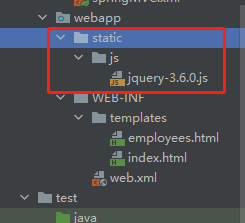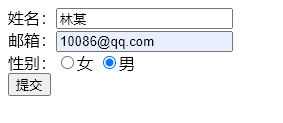文章目录
六、RESTFUL风格
6.1 RESTFul简介
REST:Representational State Transfer,表现层资源状态转移。
这里介绍几个专业术语:
-
资源:资源是一种看待服务器的方式,即,将服务器看作是由很多离散的资源组成。每个资源是服务器上一个可命名的抽象概念。因为资源是一个抽象的概念,所以它不仅仅能代表服务器文件系统中的一个文件、数据库中的一张表等等具体的东西,可以将资源设计得非常抽象,只要想象力允许而且客户端应用开发者能够理解。与面向对象设计类似,资源是以名词为核心来组织的,首先关注的是名词。一个资源可以由一个或多个 URl 来标识。 URI 既是资源的名称,也是资源在 Web 上的地址。对某个资源感兴趣的客户端应用,可以贡酬寸资源的 URI 与其进行交互。
-
资源的表述:资源的表述是一段对于资源在某个特定时刻的状态的描述。可以在客户端一服务器端之间转移(交换)。资源的表述可以有多种格式,例如HTML/XML/JSON/纯文本/图片/视频/音频等等。资源的表述格式可以通过协商机制来确定。请求一响应方向的表述通常使用不同的格式。
-
状态转移:在客户端和服务器端之间转移( transfer )代表资源状态的表述。通过转移和操作资源的表述,来间接实现操作资源的目的。
6.2 RESTFul的实现
前面写了那么多东西,相信很多人应该反而被绕晕了吧。没关系,我们要开始讲人话,贴代码了。
先简单提一下之前说过的一个点吧,HTTP协议中,有四个表示操作方式的动词:GET、POST、PUT、DELETE。
这四个动词分别对应四种基本操作:GET用来获取资源,POST用来新建资源,PUT用来更新资源,DELETE用来删除资源。
REST风格提倡URL地址使用统一的风格设计,从前到后各个单词使用斜杠分开,不适用问号键值对方式携带请求参数,而是将要发送给服务器的数据作为URL地址的一部分,以保证整体风格的一致性。
给个表格吧,看一眼你就懂了。
| 操作 | 传统方式 | REST风格 |
|---|---|---|
| 增 | addUser | user ——> post请求方式 |
| 删 | deleteUser?id=1 | user/1 ——> delete请求方式 |
| 改 | updateUser | user ——> put请求方式 |
| 查 | getUserById?id=1 | user/1 ——> get请求方式 |
下面,就让我们使用RESTFul模拟下用户资源的增加和查找吧。先写一个
UserController.java类:
package com.example.controller;
import org.springframework.stereotype.Controller;
import org.springframework.web.bind.annotation.GetMapping;
import org.springframework.web.bind.annotation.PostMapping;
import org.springframework.web.bind.annotation.RequestMapping;
@Controller
public class UserController {
@RequestMapping("/restful")
public String toResuful(){
return "restful";
}
/*
* 使用RESTFul模拟用户资源的增删改查
* /user GET请求 查询所有用户信息
* /user/1 GET请求 根据用户id查询用户信息
* /user POST请求 添加用户信息
* /user/1 DELETE请求 删除用户信息
* /user PUT请求 修改用户信息
*/
@GetMapping("/user")
public String getAllUser(){
System.out.println("查询所有用户信息");
return "success";
}
@GetMapping("/user/{id}")
public String getUserById(){
System.out.println("根据用户id查询用户信息");
return "success";
}
@PostMapping("/user")
public String addUser(String username, String password){
System.out.println("添加用户信息:"+username+", "+password);
return "success";
}
}
然后写一下存放我们各种超链接的网页:
restful.html
<!DOCTYPE html>
<html lang="en" xmlns:th="http://www.thymeleaf.org">
<head>
<meta charset="UTF-8">
<title>REST风格</title>
</head>
<body>
<a th:href="@{/user}">查询所有用户信息</a><br>
<a th:href="@{/user/1}">根据id查询用户信息</a><br>
<form th:action="@{/user}" method="post">
用户名:<input type="text" name="username">
密 码:<input type="password" name="password">
<input type="submit" value="添加用户信息">
</form>
</body>
</html>
重启服务器后:
来到我们的restful.html页面,分别点击上面两个超链接并输入用户名和密码后点击添加用户信息。

此时控制台显示如下:

6.3 HiddenHttpMethodFilter
由于浏览器只支持发送get和post方式的请求,SpringMVC便给我们提供了一个HiddenHttpMethodFilter帮助我们将POST请求转换为DELETE或PUT请求。
HiddenHttpMethodFilter处理put和delete请求的条件有以下:
1、当前请求的请求方式必须为post
2、当前请求必须传输请求参数 _method
演示代码如下:
先在web.xml中配置我们的HiddenHttpMethodFilter。(最好配置在CharacterEncodingFilter后边,否则会有中文乱码的问题)
<!--配置HiddenHttpMethodFilter-->
<filter>
<filter-name>HiddenHttpMethodFilter</filter-name>
<filter-class>org.springframework.web.filter.HiddenHttpMethodFilter</filter-class>
</filter>
<filter-mapping>
<filter-name>HiddenHttpMethodFilter</filter-name>
<url-pattern>/*</url-pattern>
</filter-mapping>
然后在Controller下添加方法:
@PutMapping("/user")
public String updateUser(String username, String password){
System.out.println("修改用户信息:"+username+", "+password);
return "success";
}
@DeleteMapping("/user/{id}")
public String deleteUserById(){
System.out.println("删除用户信息");
return "success";
}
最后在restful.html中添加超链接:
<form th:action="@{/user}" method="post">
<!--
要想使用put和delete必须要有_method请求参数
因为这个是用户不需要知道的,所以我们将它隐藏即可
-->
<input type="hidden" name="_method" value="put">
用户名:<input type="text" name="username">
密 码:<input type="password" name="password">
<input type="submit" value="修改用户信息">
</form>
<br>
<!--一般删除不会这么写哈,这里只是为了演示-->
<form th:action="@{/user/1}" method="post">
<input type="hidden" name="_method" value="delete">
<input type="submit" value="删除用户信息">
</form>
<br>
6.4 完整的代码案例
首先,我们肯定先配置我们的依赖,也就是修改我们的pom.xml文件(这里只是学习RESTFul,因此并没有引入数据库的依赖)
pom.xml
<?xml version="1.0" encoding="UTF-8"?>
<project xmlns="http://maven.apache.org/POM/4.0.0"
xmlns:xsi="http://www.w3.org/2001/XMLSchema-instance"
xsi:schemaLocation="http://maven.apache.org/POM/4.0.0 http://maven.apache.org/xsd/maven-4.0.0.xsd">
<modelVersion>4.0.0</modelVersion>
<groupId>org.example</groupId>
<artifactId>mvc_demo1</artifactId>
<version>1.0-SNAPSHOT</version>
<packaging>war</packaging>
<properties>
<maven.compiler.source>8</maven.compiler.source>
<maven.compiler.target>8</maven.compiler.target>
</properties>
<dependencies>
<!--SpringMVC-->
<dependency>
<groupId>org.springframework</groupId>
<artifactId>spring-webmvc</artifactId>
<version>5.3.9</version>
</dependency>
<!--日志-->
<dependency>
<groupId>ch.qos.logback</groupId>
<artifactId>logback-classic</artifactId>
<version>1.2.3</version>
<scope>test</scope>
</dependency>
<!--ServletAPI-->
<dependency>
<groupId>javax.servlet</groupId>
<artifactId>javax.servlet-api</artifactId>
<version>4.0.1</version>
<scope>provided</scope>
</dependency>
<!--Spring5和Thymeleaf整合包-->
<dependency>
<groupId>org.thymeleaf</groupId>
<artifactId>thymeleaf-spring5</artifactId>
<version>3.0.12.RELEASE</version>
</dependency>
</dependencies>
</project>
然后就写我们整个项目的配置文件web.xml:
<?xml version="1.0" encoding="UTF-8"?>
<web-app xmlns="http://xmlns.jcp.org/xml/ns/javaee"
xmlns:xsi="http://www.w3.org/2001/XMLSchema-instance"
xsi:schemaLocation="http://xmlns.jcp.org/xml/ns/javaee http://xmlns.jcp.org/xml/ns/javaee/web-app_4_0.xsd"
version="4.0">
<!--配置编码过滤器,解决中文乱码问题-->
<filter>
<filter-name>CharacterEncodingFilter</filter-name>
<filter-class>org.springframework.web.filter.CharacterEncodingFilter</filter-class>
<init-param>
<param-name>encoding</param-name>
<param-value>UTF-8</param-value>
</init-param>
<init-param>
<param-name>forceResponseEncoding</param-name>
<param-value>true</param-value>
</init-param>
</filter>
<filter-mapping>
<filter-name>CharacterEncodingFilter</filter-name>
<url-pattern>/*</url-pattern>
</filter-mapping>
<!--配置HiddenHttpMethodFilter-->
<filter>
<filter-name>HiddenHttpMethodFilter</filter-name>
<filter-class>org.springframework.web.filter.HiddenHttpMethodFilter</filter-class>
</filter>
<filter-mapping>
<filter-name>HiddenHttpMethodFilter</filter-name>
<url-pattern>/*</url-pattern>
</filter-mapping>
<!--配置SpringMVC的前端控制器,对浏览器发送的请求进行统一处理-->
<servlet>
<servlet-name>SpringMVC</servlet-name>
<servlet-class>org.springframework.web.servlet.DispatcherServlet</servlet-class>
<!--配置SpringMVC配置文件的位置和名称-->
<init-param>
<param-name>contextConfigLocation</param-name>
<param-value>classpath:springMVC.xml</param-value>
</init-param>
<!--将前端控制器DispatcherServlet的初始化时间提前到服务器启动时-->
<load-on-startup>1</load-on-startup>
</servlet>
<servlet-mapping>
<servlet-name>SpringMVC</servlet-name>
<!--
使用/可以拦截 /login、 .html、 .js 、.css方式的请求
但是不能拦截 .jsp的请求,如果要把.jsp文件也拦下来,那么就得用/*
-->
<url-pattern>/</url-pattern>
</servlet-mapping>
</web-app>
然后因为我们使用的是SpringMVC的框架,所以我们还得创建SpringMVC的配置文件:
<?xml version="1.0" encoding="UTF-8"?>
<beans xmlns="http://www.springframework.org/schema/beans"
xmlns:xsi="http://www.w3.org/2001/XMLSchema-instance"
xmlns:context="http://www.springframework.org/schema/context"
xmlns:mvc="http://www.springframework.org/schema/mvc"
xsi:schemaLocation="http://www.springframework.org/schema/beans
http://www.springframework.org/schema/beans/spring-beans.xsd
http://www.springframework.org/schema/context
https://www.springframework.org/schema/context/spring-context.xsd
http://www.springframework.org/schema/mvc
https://www.springframework.org/schema/mvc/spring-mvc.xsd">
<!--扫描组件-->
<context:component-scan base-package="com.example"/>
<!--配置Thymeleaf视图解析器(针对h5文件,抄就完了)-->
<bean id="viewResolver" class="org.thymeleaf.spring5.view.ThymeleafViewResolver">
<property name="order" value="1"/>
<property name="characterEncoding" value="UTF-8"/>
<property name="templateEngine">
<bean class="org.thymeleaf.spring5.SpringTemplateEngine">
<property name="templateResolver">
<bean class="org.thymeleaf.spring5.templateresolver.SpringResourceTemplateResolver">
<!--视图前缀-->
<property name="prefix" value="/WEB-INF/templates/"/>
<!--视图后缀-->
<property name="suffix" value=".html"/>
<property name="templateMode" value="HTML5"/>
<property name="characterEncoding" value="UTF-8"/>
</bean>
</property>
</bean>
</property>
</bean>
<!--
处理静态资源,如html、js、css、jpg
若只设置该标签,则只访问静态资源,其他请求无法访问
此时必须设置<mvc:annotation-driven/>解决问题
-->
<mvc:default-servlet-handler/>
<!--开启mvc注解驱动-->
<mvc:annotation-driven>
<mvc:message-converters>
<!--处理响应中文乱码问题-->
<bean class="org.springframework.http.converter.StringHttpMessageConverter">
<property name="defaultCharset" value="UTF-8"/>
<property name="supportedMediaTypes">
<list>
<value>text/html</value>
<value>application/json</value>
</list>
</property>
</bean>
</mvc:message-converters>
</mvc:annotation-driven>
</beans>
之后呢,我们就开始写我们的po层的代码,比如创建一个员工类
Employee.java:(一般是写一个有参构造加一个无参构造加所有的get和set方法再重写一个toString方法)
package com.example.po;
public class Employee {
private Integer id; //唯一标识
private String name; //姓名
private String email; //邮箱
private Integer gender; //性别
public Employee() {
}
public Employee(Integer id, String name, String email, Integer gender) {
this.id = id;
this.name = name;
this.email = email;
this.gender = gender;
}
public Integer getId() {
return id;
}
public void setId(Integer id) {
this.id = id;
}
public String getName() {
return name;
}
public void setName(String name) {
this.name = name;
}
public String getEmail() {
return email;
}
public void setEmail(String email) {
this.email = email;
}
public Integer getGender() {
return gender;
}
public void setGender(Integer gender) {
this.gender = gender;
}
@Override
public String toString() {
return "Employee{" +
"id=" + id +
", name='" + name + '\'' +
", email='" + email + '\'' +
", gender=" + gender +
'}';
}
}
然后就写我们的dao层:(一般的写法其实是写一个Dao接口,再写一个DaoImpl实现类,再写一个service类来调用),但是这里相当于把这三个合并成一个直接拿来用。
EmployeeDao.java
package com.example.dao;
import com.example.po.Employee;
import java.util.Collection;
import java.util.HashMap;
import java.util.Map;
public class EmployeeDao {
/*模拟数据库*/
private static Map<Integer, Employee> employees = null;
static {
employees = new HashMap<Integer, Employee>();
/*假设数据库中现有以下六条数据*/
employees.put(1001,new Employee(1001, "林一", "123@qq.com", 0));
employees.put(1002,new Employee(1002, "黄二", "456@qq.com", 1));
employees.put(1003,new Employee(1003, "张三", "789@qq.com", 0));
employees.put(1004,new Employee(1004, "李四", "321@qq.com", 1));
employees.put(1005,new Employee(1005, "王五", "654@qq.com", 0));
employees.put(1006,new Employee(1006, "刘六", "987@qq.com", 1));
}
/*模拟数据库的自增id*/
private static Integer initId = 1007;
/*增加一个Employee对象*/
public void save(Employee employee){
if (employee.getId() == null){
employee.setId(initId++);
}
employees.put(employee.getId(),employee);
}
/*返回所有的Employees对象*/
public Collection<Employee> getAll(){
return employees.values();
}
/*通过id返回Employee对象*/
public Employee get(Integer id){
return employees.get(id);
}
/*通过id删除Employee对象*/
public void delete(Integer id){
employees.remove(id);
}
}
然后我们根据下面的功能清单,写我们的控制器方法和超链接。

6.4.1 查询功能
先演示一个查询的功能。
EmployeeController.java代码如下:
package com.example.controller;
import com.example.dao.EmployeeDao;
import com.example.po.Employee;
import org.springframework.stereotype.Controller;
import org.springframework.web.bind.annotation.GetMapping;
import org.springframework.web.bind.annotation.PathVariable;
import org.springframework.web.servlet.ModelAndView;
import javax.annotation.Resource;
import java.util.Collection;
@Controller
public class EmployeeController {
@Resource
private EmployeeDao employeeDao;
@GetMapping("/")
public String toIndex(){
return "index";
}
@GetMapping("/employee")
public ModelAndView getAllEmployee(ModelAndView modelAndView){
Collection<Employee> employees = employeeDao.getAll();
//保存数据到request域对象
modelAndView.addObject("employees", employees);
//设置跳转的视图为employees.html
modelAndView.setViewName("employees");
return modelAndView;
}
@GetMapping("/employee/{id}")
public ModelAndView getEmployeeById(ModelAndView modelAndView, @PathVariable Integer id){
Employee employee = employeeDao.get(id);
/*保存数据到request对象*/
modelAndView.addObject("employees", employee);
/*设置跳转的视图为employees.html*/
modelAndView.setViewName("employees");
return modelAndView;
}
}
然后写我们的首页:
index.html
<!DOCTYPE html>
<html lang="en" xmlns:th="http://www.thymeleaf.org">
<head>
<meta charset="UTF-8">
<title>首页</title>
</head>
<body>
<h1>首页</h1>
<a th:href="@{/employee}">查询所有员工信息</a><br>
<a th:href="@{/employee/1001}">查询id为1001的员工信息</a><br>
</body>
</html>
最后我们陈列(显示数据)的页面:
employees.html
<!DOCTYPE html>
<html lang="en" xmlns:th="http://www.thymeleaf.org">
<head>
<meta charset="UTF-8">
<title>员工信息列表</title>
<style type="text/css">
table{
border: 1px solid black;
width: 50%;
/*表格对于整体居中*/
margin: 0 auto;
/*表格中的文字居中*/
text-align: center;
}
td,th{
border: 1px solid black;
}
</style>
</head>
<body>
<table>
<tr>
<!--设置让他独占五列-->
<th colspan="5">员工信息列表</th>
</tr>
<tr>
<th>工号</th>
<th>姓名</th>
<th>邮箱</th>
<th>性别</th>
<th>选项</th>
</tr>
<!--
这里的用法类似于for(Employee item : employees)
th:each表示的是取到的集合中的每一个对象
: ${employees} 表示遍历request域中的employees
-->
<tr th:each="item : ${employees}">
<td th:text="${item.id}"></td>
<td th:text="${item.name}"></td>
<td th:text="${item.email}"></td>
<td th:text="${item.gender}"></td>
<td>
<a href="">删除</a>
<a href="">修改</a>
</td>
</tr>
</table>
</body>
</html>
启动服务器:

点击查询所有员工信息显示:

点击查询id为1001的用户信息显示:

6.4.2 删除功能
然后我们说一下删除功能(直接贴代码):
首先我们要引入我们的jQuery

然后,我们在控制器中添加方法:
@DeleteMapping("/employee/{id}")
public ModelAndView removeById(ModelAndView modelAndView, @PathVariable("id") Integer id){
/*删除*/
employeeDao.delete(id);
modelAndView.setViewName("redirect:/employee");
return modelAndView;
}
再修改我们的employee.html页面如下:
<!DOCTYPE html>
<html lang="en" xmlns:th="http://www.thymeleaf.org">
<head>
<meta charset="UTF-8">
<title>员工信息列表</title>
<style type="text/css">
table{
border: 1px solid black;
width: 50%;
/*表格对于整体居中*/
margin: 0 auto;
/*表格中的文字居中*/
text-align: center;
}
td,th{
border: 1px solid black;
}
</style>
</head>
<body>
<table>
<tr>
<!--设置让他独占五列-->
<th colspan="5">员工信息列表</th>
</tr>
<tr>
<th>工号</th>
<th>姓名</th>
<th>邮箱</th>
<th>性别</th>
<th>选项</th>
</tr>
<!--
这里的用法类似于for(Employee item : employees)
th:each表示的是取到的集合中的每一个对象
: ${employees} 表示遍历request域中的employees
-->
<tr th:each="item : ${employees}">
<td th:text="${item.id}"></td>
<td th:text="${item.name}"></td>
<td th:text="${item.email}"></td>
<td th:text="${item.gender}"></td>
<td>
<a class="deleteOption" th:href="@{'/employee/'+${item.id}}">删除</a>
<a id="updateOption" th:href="@{/employee}">修改</a>
</td>
</tr>
</table>
<!--删除表单-->
<form id="deleteForm" method="post">
<input type="hidden" name="_method" value="delete">
</form>
<script type="text/javascript" th:src="@{/}+'/static/js/jquery-3.6.0.js'"></script>
<script type="text/javascript">
$(function (){
$(".deleteOption").click(function (event){
/*获取a标签的href*/
$("#deleteForm").attr("action",$(this).attr("href"));
/*提交form表单*/
$("#deleteForm").submit();
//取消超链接的默认行为
event.preventDefault();
})
});
</script>
</body>
</html>
6.4.3 添加功能
接着说一下添加功能,代码如下:
现在index中添加一个超链接跳转到页面添加员工信息。
index.html
<!DOCTYPE html>
<html lang="en" xmlns:th="http://www.thymeleaf.org">
<head>
<meta charset="UTF-8">
<title>首页</title>
</head>
<body>
<h1>首页</h1>
<a th:href="@{/employee}">查询所有员工信息</a><br>
<a th:href="@{/employee/1001}">查询id为1001的员工信息</a><br>
<a th:href="@{/toAdd}">添加员工信息</a>
</body>
</html>
然后写我么你的添加员工信息的页面:
employee_add.html
<!DOCTYPE html>
<html lang="en" xmlns:th="http://www.thymeleaf.org">
<head>
<meta charset="UTF-8">
<title>添加员工信息</title>
</head>
<body>
<form th:action="@{/employee}" method="post">
姓名:<input type="text" name="name"><br>
邮箱:<input type="text" name="email"><br>
性别:<input type="radio" name="gender" value="0">女
<input type="radio" name="gender" value="1">男 <br>
<input type="submit" value="提交"><br>
</form>
</body>
</html>
再在Controller中补两个方法:
@GetMapping("/toAdd")
public String toAdd(){
return "employee_add";
}
@PostMapping("/employee")
public ModelAndView addEmployee(Employee employee,ModelAndView modelAndView){
employeeDao.save(employee);
modelAndView.setViewName("redirect:/employee");
return modelAndView;
}
重启服务器:

输入信息后点击提交

结果:

6.4.4 修改功能
先修改我们之前的index页面(去掉查询个人的功能):
index.html
<!DOCTYPE html>
<html lang="en" xmlns:th="http://www.thymeleaf.org">
<head>
<meta charset="UTF-8">
<title>首页</title>
</head>
<body>
<h1>首页</h1>
<a th:href="@{/employee}">查询所有员工信息</a><br>
<a th:href="@{/toAdd}">添加员工信息</a>
</body>
</html>
然后写一个修改的页面:
<!DOCTYPE html>
<html lang="en" xmlns:th="http://www.thymeleaf.org">
<head>
<meta charset="UTF-8">
<title>修改员工信息</title>
</head>
<body>
<form th:action="@{/employee}" method="post">
<input type="hidden" name="_method" value="put">
<input type="hidden" name="id" th:value="${employee.id}">
姓名:<input type="text" name="name" th:value="${employee.name}"><br>
邮箱:<input type="text" name="email" th:value="${employee.email}"><br>
性别:<input type="radio" name="gender" value="0" th:field="${employee.gender}">女
<input type="radio" name="gender" value="1" th:field="${employee.gender}">男 <br>
<input type="submit" value="修改"><br>
</form>
</body>
</html>
最后写两个控制器方法:(第一个getEmployeeById之前写过,需要更改)
@GetMapping("/employee/{id}")
public ModelAndView getEmployeeById(ModelAndView modelAndView, @PathVariable("id") Integer id){
Employee employee = employeeDao.get(id);
/*保存数据到request对象*/
modelAndView.addObject("employee", employee);
/*设置跳转的视图为employees.html*/
modelAndView.setViewName("employee_update");
return modelAndView;
}
@PutMapping("/employee")
public ModelAndView updateEmployee(ModelAndView modelAndView, Employee employee){
employeeDao.save(employee);
modelAndView.setViewName("redirect:/employee");
return modelAndView;
}
然后重启服务器:
演示就不演示了,直接看结果把。这里把王五改成了哈哈。























 118
118











 被折叠的 条评论
为什么被折叠?
被折叠的 条评论
为什么被折叠?








